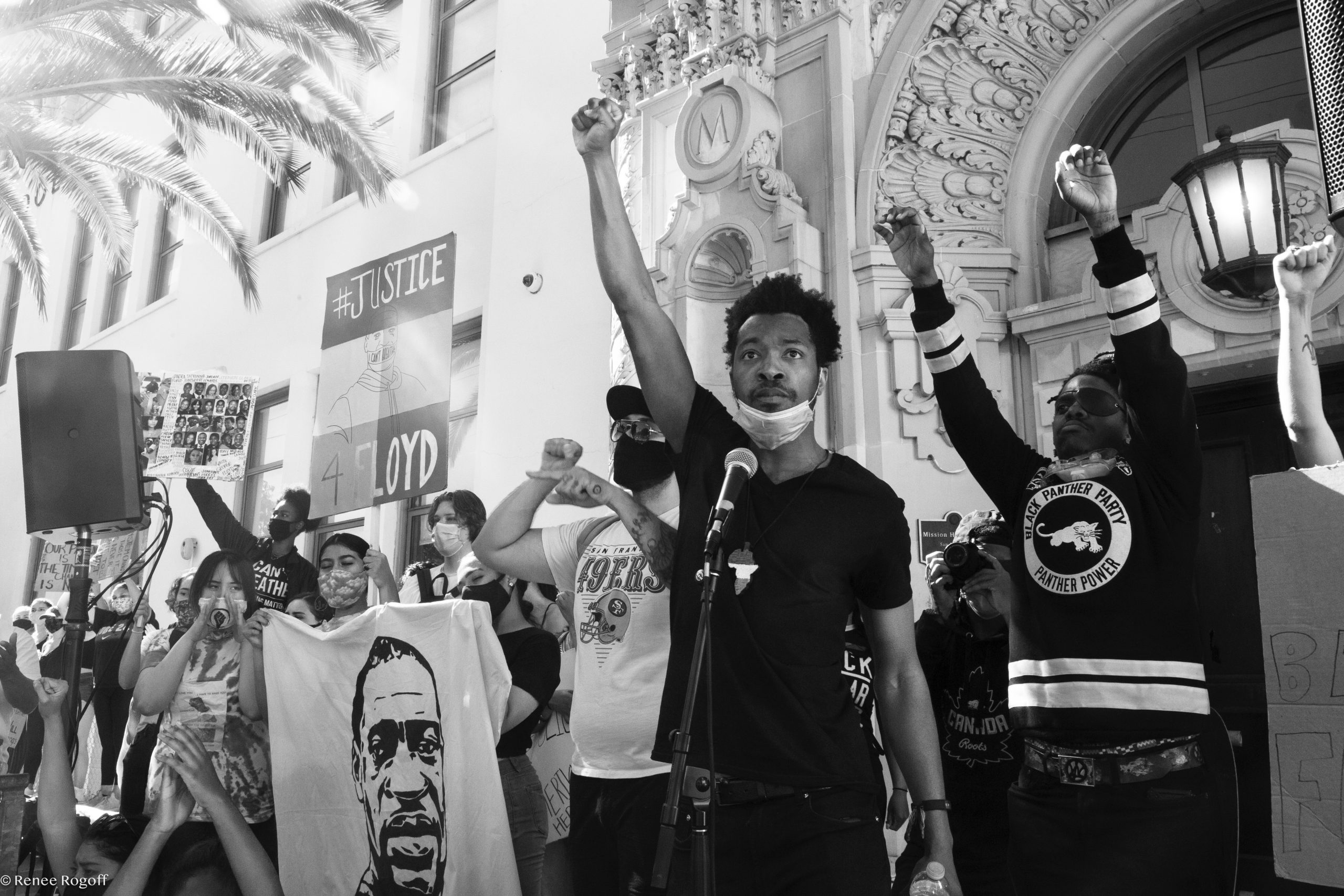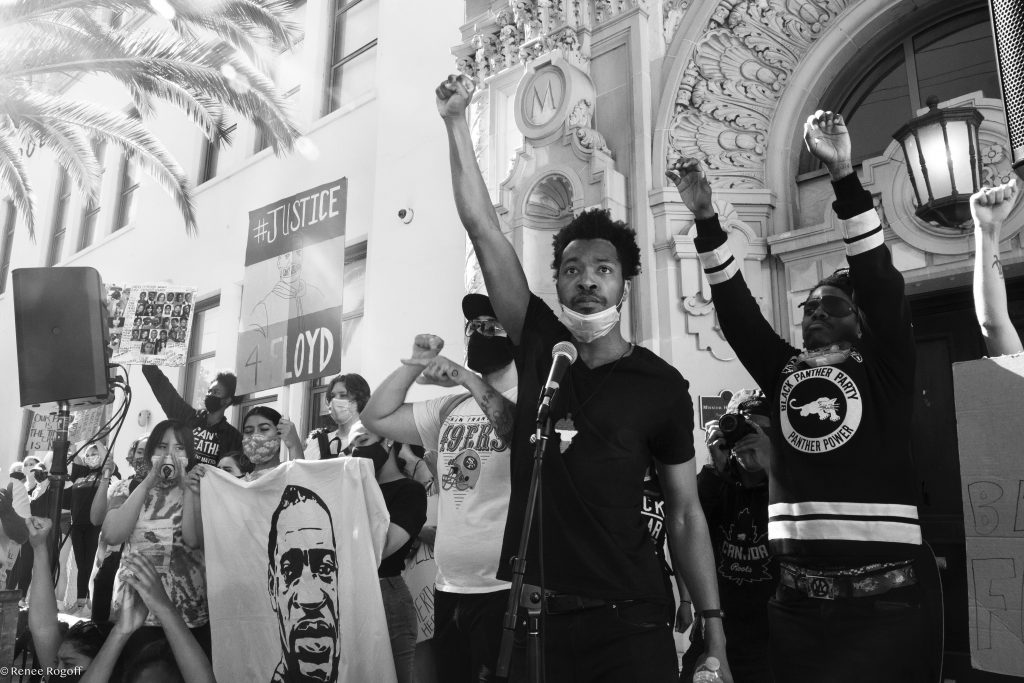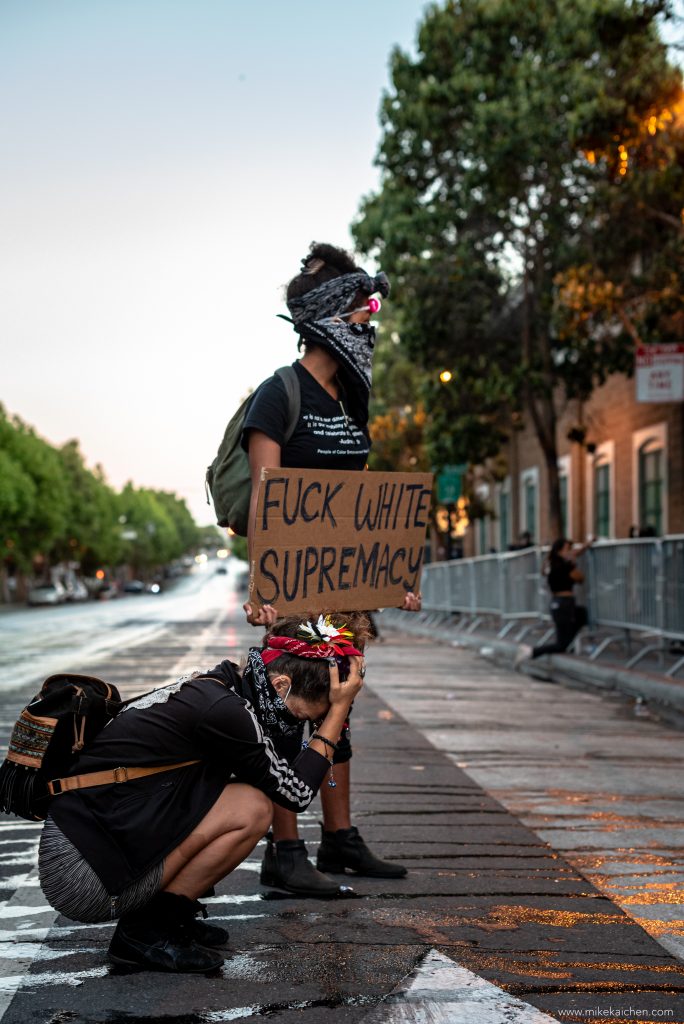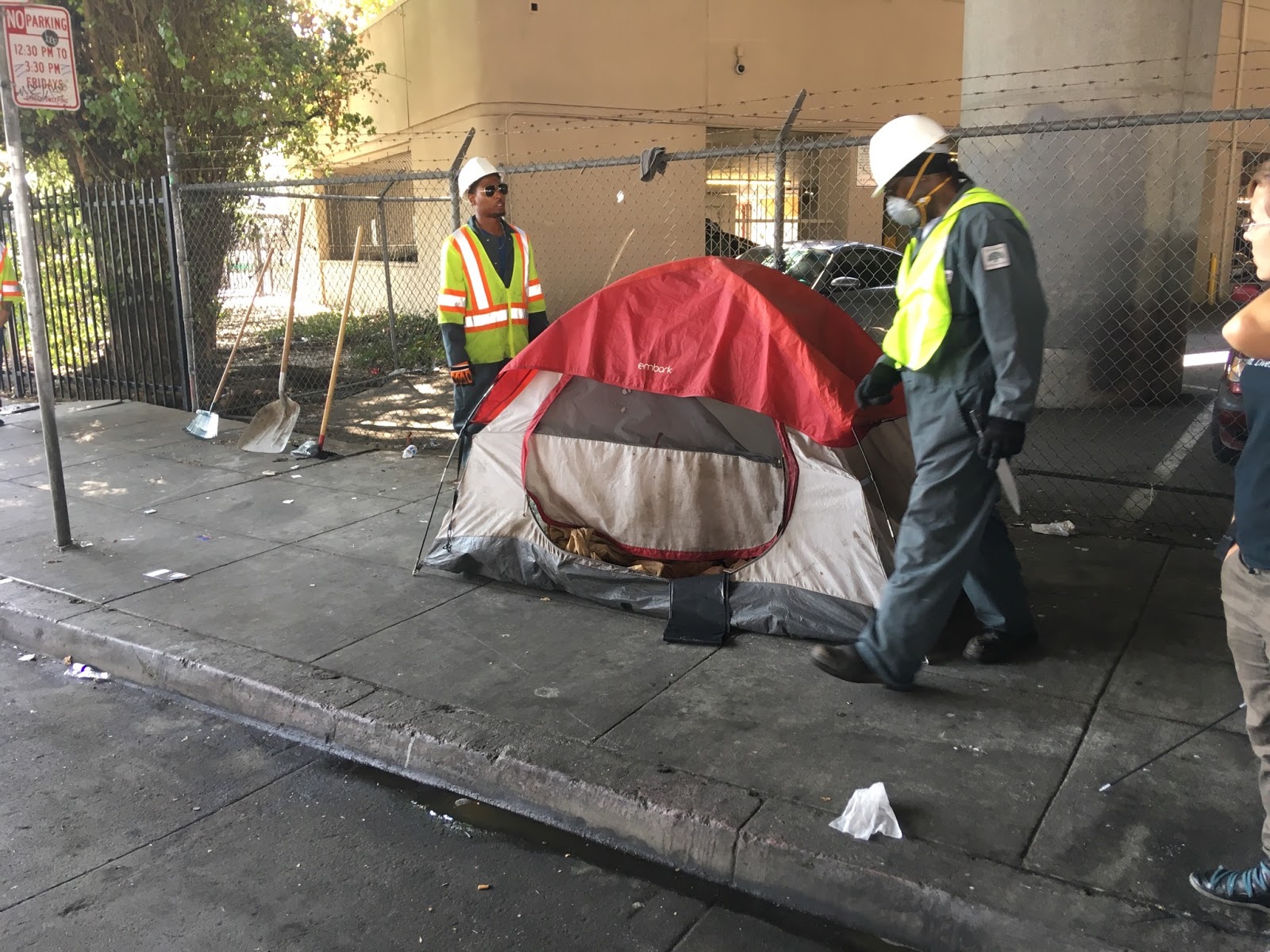
By Iris Crawford and Sarah Belle Lin
The global movement in the wake of George Floyd’s death has made the Black Lives Matter movement stronger than ever. By now, it’s become a familiar sight seeing masked people marching, chanting, and even dancing in the streets. But what are the stories of some of the individuals out on the streets? Oakland Voices correspondent Iris Crawford and contributor Sarah Belle Lin talked to four individuals seen and heard at the Oakland demonstrations to learn more about their stories.
Michael Houston

Michael Houston has been an active and rising presence in the recent protests. Hailing from Brooklyn, New York, Houston has lived in the Bay Area for three years. Having experienced the Black Lives Matter movement in other spaces, Houston has since carved out his message for the community. “This time around, I have a message I want to contribute to the movement and to the world,” Houston said. “I also have more clarity on using my art to truly make a difference as a creative.”
On the first day of protests in Oakland on May 29, Houston spoke up in front of the line of police and drew attention from those near him. “If you see them swinging on us, we gotta swing back with love,” Houston said that evening.” By “they”, he means the police and other oppressive entities. Houston had told the line of police on May 29 that when they take off their uniforms, they’re human beings, and that their jobs shouldn’t run their lives. “I feel like as a community, as a people, we have to look at each other with so much love that we are willing to defend each other in that love and not look at it as violence,” Houston said. It’s a message he also shared at the “Fuck Your Curfew” event in Oakland on June 3, where protesters filled the streets around the Oscar Grant Plaza to demonstrate post-curfew.
The problem with America, Houston believes, is a lack of moral consciousness. “There are some police officers who cannot wait to use those shields and tear gas and on Friday [May 29], that’s what happened,” said Houston. “No one wants to go to war. No one wants to fight. But when you put up your guard, then our guards are up.” That first night of protests in Oakland resulted in police firing tear gas, flash bang grenades, and less-lethal projectiles at protesters.
Houston was detained and cited twice during the recent protests. Houston remembered the first time he was detained with a crowd of around 50 protesters, he had his photo taken, cited, and threatened with arrest. “The reality is that the violence that we experienced from those police officers causes us to be very wary of any officer, good or bad,” said Houston. While the Oakland Police Department has a police commission that oversees policies and practices of OPD to meet national standards of constitutional policy, Houston would like to see independent oversight committees created nationwide to maximize accountability for police departments. He urges police officers to act more responsibly and help to weed out racist and violent officers if they want to begin changing the narrative.
Houston says those who have been historically pushed to the side are now asking for their fair and rightful share. This might mean there will be a restructuring of normality. In order to level the playing field, one side will have to make sacrifices for the good of the community. Being an ally is much more than protesting, Houston said. Being an ally is being proactive 24/7, 365 days a year. “We’re in the Bay Area, tech capital of America,” said Houston. “Those allies need to go back to those tech companies and be proactive in their allyship. That means they need to demand diversity and inclusion.” When Houston first moved to San Francisco in 2016, he worked for a company that catered to different tech companies. “Literally the only Black faces I saw were security guards and maybe two or three Black employees,” said Houston. The tech sector has come under fire for its lack of diversity and inclusion and Houston says tech company employees will be protesting and saying ‘Black Lives Matter,’ which is appreciated, but not enough. They need to use their privilege and demand to see more Black faces from their executives and not just hire Black employees in low-level positions, but in positions of power, Houston stated. What he hopes to see in the coming days is an understanding that this is a continued revolution. “It’s very important now for allies to really affect change in their own communities, to educate themselves and make room for Black people in communities,” Houston said. – Sarah Belle Lin
Alexcia Sundra

Alexcia Sundra is from St. Paul, Minnesota. As someone who identifies as bi-racial, she has had to deal with the microaggressions from the white side of her family for years which leaves their relationship fragmented. One of her earliest memories in personally dealing with racism was in second grade. Originally, she lived in the suburbs of St. Paul but by the time she was five, her family had moved to the East Side, which, although still family-oriented, was vastly different from her old neighborhood. One big difference was the quality of education. At her new school, benchmark reading assessments were used to gauge student’s skill levels. Her new second grade teacher accused her of cheating on the assessment tests because she was quite ahead of her fellow classmates in the subject. As she reflects, it was shocking to her that a teacher would not give a second grader the benefit of the doubt. The school was a potential-dampening environment for its students but she remains grateful to her father who was able to advocate for her. “Standardized testing is a big deal in Minnesota which can determine the quality of your education,” Sundra said. It is a huge problem in the Twin Cities where young Black and brown children are not given the tools they need to succeed if they want too. Minnesota is in the midst of its final redistricting plan that seeks to address issues of racial disparities by decreasing the number of segregated schools and close the achievement gap.
Sundra attended some of Oakland’s earliest protests such as the Car Caravan organized by the Anti Police Terror Project. She wants to speak and listen to the people that have been called to action. “The more that we talk, the more we can come together to reimagine a different future,” Sundra said. She has been working on the creation of restoration spaces during protests so that people can synthesize their different ideas while capturing and infusing intention and community into what they are doing. “How do we create those spaces at protests as well as every day?’” asks Sundra. – Iris Crawford
Brianna Noble

Brianna Noble is now immortalized as the woman who showed up on horseback during the first day of protests in Oakland. Noble is 25 years-old and grew up in Oakland. She currently lives in Pinole and owns a horseback riding center called Mulatto Meadows in Martinez. For a long time, Noble felt like she had to make herself less visible as a Black woman in the equestrian world. “Being a horse woman in this world gives you a very interesting perspective on racism because [the equestrian world] can be such a racist place as a Black woman,” Noble said. “It’s a very concentrated place because there are so few Black people that ride and ride professionally.”
Noble grew frustrated watching the media and people she knew focusing on the side effects of the protests, particularly the looting. “I can understand why the media focuses so much on that stuff. But I got to thinking, what’s a better story? How can I change the focus, and what can get somebody’s attention more than a Black woman on a big, gorgeous, very well-trained horse?” So that’s what Noble did. On Friday, May 29, Noble took her 1,800 pound horse, Dapper Dan, to downtown Oakland. She was embraced and cheered on the moment she arrived and stepped into place leading the crowd on Broadway Avenue in downtown Oakland.
“We were put in some very sketchy situations with people surrounding us in motorcycles and revving engines and doing things that normally spook these animals,” said Noble. “But he had my back and kept me and everyone safe.” This was not Dapper Dan’s first rodeo, as he also made an appearance during the Black Joy Parade in February.
“I didn’t realize it was going to get this big,” said Noble. “This is something that the world is going to take notice of.” There’s now a mural of Noble riding Dapper Dan outside of Luka’s Taproom. Going forward, Noble would like to offer horseback riding lessons to youth, especially those from low-income backgrounds. She’s working on a program called The Humble Project, which will use horses as a medium to inspire positive futures. “’I’m hoping to bring out kids who are low-income and offer riding lessons to them for free,” Noble said. “That’s really what my goal is because there are little to no opportunities for Black and brown people in the horse world.”
As much as she’d love to see under-resourced children enter the world she is so passionate about, she has her sights on breaking more records herself. “I’d love to be the first Black woman to go to the Olympics and compete in an equestrian event,” said Noble. Her advice to others is advice she’s received herself: find your power with the collective purpose and when in doubt, ride a horse. It can very well turn out to be your superpower. “My superpower is communicating with horses,” Noble said. “I’m going to do as much good as I can using my superpower.”
To support The Humble Project, you can donate directly to Noble’s Paypal at briannanoble@mulattomeadows.com with the note “Humble Project donation.” – Sarah Belle Lin
Selena De Leon

For Selena De Leon, these protests and the larger Black Lives Matter Movement have a very deep significance. De Leon is from Milwaukee, Wisconsin which is one of the most racially segregated and politically polarized cities in the country and historically, racial tensions have run high. African Americans are four times more likely to be living in poverty and Milwaukee is considered one of the worst places for this demographic to live. “The police like to incite fear and whenever I am pulled over, my first thought is where do I put my hands?” De Leon said. Following Trump’s election, she recounts her experience at Lawrence College in Appleton Wisconsin, where a man in full Ku Klux Klan regalia holding a Trump flag walked near campus and police did nothing to ensure the safety of students of color. In college, she was always politically active and raised her voice about many of the university’s diversity issues. However, what sparked her move to the San Francisco Bay Area was when her life was threatened online. A white man in Minneapolis promised to track her down and harm her with an assault rifle. A friend of hers reported the incident to the police which prompted an officer to visit the campus and interview her. As the interview went on, the officer said that De Leon was “getting aggressive” and the officer subsequently made a gesture toward the taser, according to De Leon. That was the final straw for her in which she decided to leave the state.
She is thankful that at least in the Bay, she can go outside without being called a racial slur or automatically assumed a threat. De Leon is actively participating in protests in both Oakland and San Francisco while staying active on social media and sharing developments.
“I am a body and I know that there is strength in numbers. Even if I don’t feel like my voice is heard, I need to be there to take a stand,” De Leon said. She is tired of her people (the Black community) facing violence and sees these protests as a way to push for change on a structural level. When asked about her feelings on the current unrest, De Leon notes that the violence we are seeing is because of the injustices we face. It is not the fault of the people but instead the state and government. For the people just tuning in, she is hopeful that people see the work that is being done to dismantle unjust systems and hopes that people stay outraged until change comes. “I hope my little nieces can live in a world where they don’t have to march in the streets for the same reason that I did,” De Leon said. – Iris Crawford




Be the first to comment